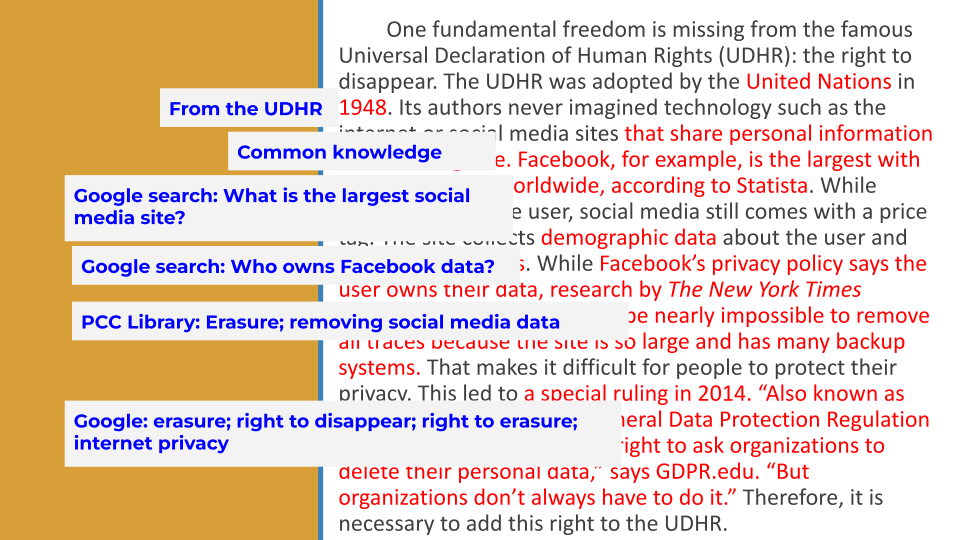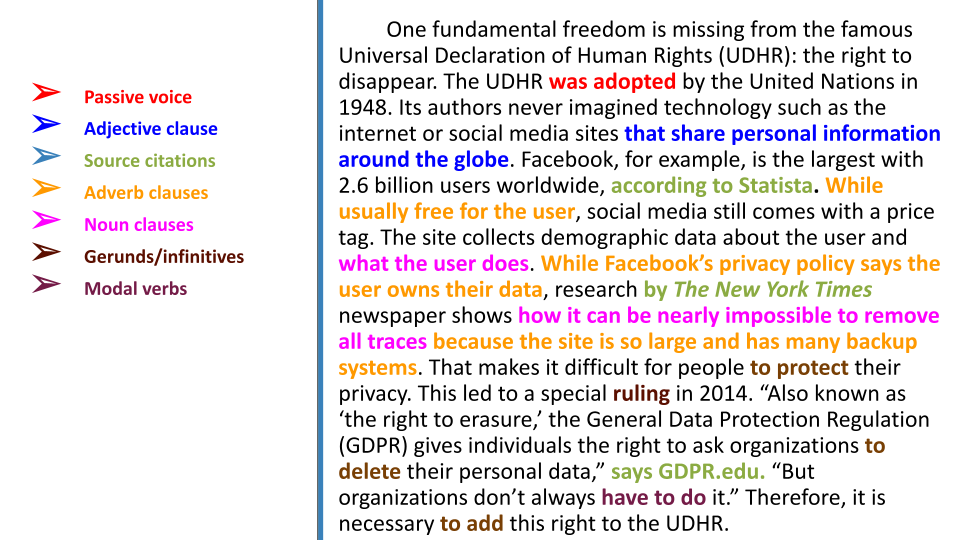42 Composition: Stronger Body Paragraphs

What are the parts of a strong body paragraph in an essay?
Let’s review. A strong body paragraph will have two important parts:
- A clear topic sentence with both topic and controlling idea (this is like a mini-thesis, but only for that paragraph)
- Several supporting sentences that provide specific supporting details to explain the topic sentence
Some instructors also suggest a concluding sentence, but not every body paragraph needs this so long as you provide a smooth transition from one idea to the next. You can do this by using signal words to guide your reader, such as first, next, then, on the other hand, nevertheless, furthermore, etc. The idea is to connect the ideas in order to make the information flow smoothly from one idea to the next.
Topic sentences
Topic sentences are like mini thesis statements for just that paragraph. They introduce the topic and the controlling idea (which is like a claim). Together, these things make a major point that helps to explain the essay’s thesis statement. The topic sentence is often the first sentence of the paragraph, especially in academic writing, but it can go in many places.
Contrast these examples of a topic sentence:
| Sugar leads to ill-health. | Sugar is often used as a substitute for fat in many foods. | High levels of sugar alter blood viscosity, rendering it thicker, which can lead to hypertension. |
| Too simple, vague, and general. Many books, not one paragraph, could be written about this. | Much better, but we lost the idea of “ill-health.” With this topic sentence, the paragraph might offer a positive or negative opinion. Therefore, it’s still a little unclear. | Here, the sentence supports the main topic of sugar leading to ill-health, and focuses on one particular reason why sugar is not good for health. |
Try it
Try it
INSTRUCTIONS: Write a topic sentence for each paragraph.
Supporting sentences
Supporting sentences explain the topic sentence. They provide information to help your reader understand — and believe — the point you are trying to make. Supporting sentences usually provide several specific supporting details, such as:
- examples
- descriptions
- definitions
- quotations
- facts
- numbers (dates, figures, statistics)
- names of people or places
- reasons or results
- explanations
- evidence from research
- steps in a process
- events in history or a timeline
According to Cambridge English Learner’s Dictionary, specific is an adjective that is “used to refer to a particular thing and not something general.”
Contrast these two examples:
- Can we meet sometime? Maybe next week or next month? My schedule is wide open.
- Could we arrange a specific time to meet tomorrow? How about 10:00AM? Are you free at that particular time?
Specific also means “exact or containing details.” The first example above is general and vague. The second example above one is specific — and more useful!
Now imagine this conversation:
A: The printer has a problem!
B: What’s wrong with it?
A: It’s not working!
B: You have to be more specific if you want me to fix it.
A: A paper jam started a fire that melted the plastic!
B: Ah! OK. Now I understand. I know what to do.
Look at this paragraph. What kinds of specific supporting details would be useful to add here?
- It was a beautiful day. The sky had interesting clouds. The wind blew through the trees. I saw birds flying around, too.
- It was a beautiful day. White clouds floated above the mountains, and the air was pure and cold. The trees outside my office swayed in the wind, and a flock of crows rode the breeze up past my window, over our small building and down past the windows on the other side.
Wait! Did you notice that this was written in the first person? Often, formal academic writing is written in the third person in order to sound more neutral. How can you edit it to be in the third person?
It was a beautiful day. White clouds floated above the mountains, and the air was pure and cold. The trees outside my the office swayed in the wind, and a flock of crows rode the breeze up past my the window, over our the small building and down past the windows on the other side.
Try it
INSTRUCTIONS: Look at this paragraph. What kinds of specific supporting details would be useful to add here?
The pandemic caused big financial problems. It caused ABC Bank and XYZ Bank to close. This caused more problems in the stock market, and a lot of people lost a lot of money.
Now look at this example paragraph:
The Universal Declaration of Human Rights (UDHR) is an old document. Many years have passed, and a lot has changed. People use the internet a lot now, and they use social media, too. People share a lot of personal information on Facebook, sometimes too much. They need privacy. People want to be able to disappear from social media. Some want to leave Facebook, but now the business controls their information. The UDHR should add a new article that guarantees that a person can remove their personal information from social media, and companies must agree to do this.
What kinds of specific supporting details would be useful to add here?
The Universal Declaration of Human Rights (UDHR) is an old document. ← How old? How many years? → Many years have passed, and a lot has changed. People use the internet a lot now, ← How much? Give a statistic to show how widespread its use is. and they use social media, too. ← define People share a lot of personal information on Facebook, sometimes too much. ← An example would be useful here; how much is a lot? how much is too much? what are people sharing? They need privacy. People want to be able to disappear from social media. ← Why? Explain Some want to leave Facebook, but now the business controls their information. ← Why? how? The UDHR should add a new article that guarantees that a person can remove their personal information from social media, and companies must agree to do this. ← Why? What happens if they do? What happens if they don’t?
Now look at how you might rewrite this paragraph with more specific supporting details:
One fundamental freedom is missing from the famous Universal Declaration of Human Rights (UDHR): the right to disappear. The UDHR was adopted by the United Nations in 1948. Its authors never imagined technology such as the internet or social media sites that share personal information around the globe. Facebook, for example, is the largest with 2.6 billion users worldwide, according to Statista. While usually free for the user, social media still comes with a price tag. The site collects demographic data about the user and what the user does. While Facebook’s privacy policy says the user owns their data, research by The New York Times newspaper shows how it can be nearly impossible to remove all traces because the site is so large and has many backup systems. That makes it difficult for people to protect their privacy. This led to a special ruling in 2014. “Also known as ‘the right to erasure,’ the General Data Protection Regulation (GDPR) gives individuals the right to ask organizations to delete their personal data,” says GDPR.edu. “But organizations don’t always have to do it.” Therefore, it is necessary to add this right to the UDHR.
Notice that the writer added many specific supporting details. These details work together to help the reader understand the idea better. They provide the proof, or evidence, that the reader needs to understand the point and to agree with the position. The details make the paragraph more useful — and more interesting!
But where did the writer get these specific supporting details? Take a look:

While you are here, take note of the different grammatical features in this paragraph:

As you do more formal, academic writing, you will see the shift from subjective writing about yourself to objective writing about other things or people. You can still share ideas and opinions, but now you support — prove — them with evidence from others. Adding these details is not easy, and it takes time. Good writing requires clear grammar and appropriate vocabulary in order to express your ideas. However, you need to start with good ideas — and you need to explain them well. That’s why specific supporting details are so important!
How can you use information from an outside source?
There are many formal rules about using information from outside sources. The one basic rule for this course is that you must always acknowledge your source(s) of information. In other words, if you are using someone else ideas — either in paraphrase or quotation — then you must tell your readers where the information came from. This avoids plagiarism, and it gives credit where credit is due. For example, if you use a statistic from a website about the number of internet users in Oregon, that’s fine. But you didn’t count them yourself. So you need to tell the reader who did. That person or organization deserves the credit — and the responsibility for the accuracy of that number. If your readers have a question, they can go directly to the source and check for themselves.
Plagiarism, on the other hand, is using someone else’s words or ideas without giving them credit. In some cultures around the world, this may not be a big deal. However, it is unacceptable in U.S. colleges. It is considered the same as stealing. (Of course, some things are “common knowledge” such as the U.S. is in North America, and you don’t have to cite a source of information for that.) If you plagiarize, then you will probably get a 0 on the assignment — and you will still have to rewrite it! Now you have twice as much work to do, and nobody wants that! Plus, if you plagiarize repeatedly, your instructor will need to report you to the Dean and you may fail the course. In some schools, students who plagiarize repeatedly are even asked to leave the school — it’s that serious!
Fortunately, you can avoid plagiarism by:
- using your own ideas
- using common knowledge (these are things most everyone knows, such as Oregon is one of the United States, but use this carefully since common knowledge is not usually very useful other than the provide context or background for something more specific information)
- using data (such as facts and statistics) — and citing the source (telling your reader where you got the information)
- paraphrasing the ideas of others (expressing the idea in your own words) — and citing the source (telling your reader where you got the information)
- quoting the words of others (repeating the exact words of the author inside “quotation marks”) — and citing the source (telling your reader where you got the information)
In more advanced courses, you will study formal citation methods that follow many difficult rules. In this course, your goal is to just get into the habit of telling your readers where your information comes from. Here are three simple ways to cite a source of information:
- According to the U.S. Census Bureau, the population of Portland, Oregon in 2020 was 650,380.
- The population of Portland, Oregon in 2020 was 650,380, according to the U.S. Census Bureau.
- The population of Portland, Oregon in 2020 was 650,380 (U.S. Census Bureau).
Remember: you can paraphrase another person’s ideas (use their idea but your words) or quote (use their idea in their exact words). Either way, you need to acknowledge the source. For example:
- If the rights of one person are taken away, then everyone suffers, said John F. Kennedy.
- As John F. Kennedy once said, “the rights of every man are diminished when the rights of one man are threatened.”
Analysis
INSTRUCTIONS: Read the supporting sentences below. Write an appropriate topic sentence. Then use the internet to add more specific supporting details from outside sources. Remember to cite your source(s).
First, riding a bicycle is good for one’s health. Sitting in a car is not. Second, riding a bicycle can save a lot of money. Cars can be quite expensive. Third, riding a bicycle is good for the environment. If more people use bicycles instead of autos or even public transportation, then everything would be a lot better.
Practice
Quiz
INSTRUCTIONS: Use the information above to answer the questions below.
1. Which of the following are examples of supporting details? (check all that apply)
A. statistics
B. thesis
C. title
D. examples
E. dates
2. Imagine a paragraph about this topic: Many people in Portland have started to make their own beer. What kinds of supporting details would be useful in this paragraph? (choose all that apply)
A. Do these people have children or grandchildren?
B. Who are the kinds of people who do this?
C. How many people?
D. What other kinds of alcohol do these people enjoy?
E. How is it legal?
F. What are the different types of beer?
G. Why do they want to make their own beer?
H. When did this trend start?
3. What are some good sources of supporting details for your essays? (choose all that apply)
A. Wikipedia
B. a stranger on the street who says he is an expert
C. newspaper or magazine with a good reputation
D. an illegal website that publishes gossip, rumors, and guesses
E. a university website that has research with evidence
F. a library encyclopedia of science vocabulary
4. Which option below is an example of a SPECIFIC supporting detail?
A. PCC was founded in 1967.
B. Today, the UDHR is outdated.
C. Portland is a city.
D. Portland Community College is very big.
5. Specific supporting details help to explain the main points of your essay. They help the reader to understand your claim. True or false?
6. What are the two parts of a topic sentence?
7. Not every body paragraph needs its own concluding sentence so long as you provide a smooth transition from one idea to the next. True or false?
8. How many specific supporting details does a strong body paragraph require?
A. Three, because all parts of an essay have three pieces.
B. Five, because we are writing a five-paragraph essay.
C. Seven, because it is more complete; people can remember no more than seven details.
D. It depends on the topic. There should be enough specific supporting details to explain the topic sentence.
9. You do not have to name our source of information if you are not using a “quotation”. True or false?
10. Which of the following sentences does not reflect good use of an outside source of information?
A. According to the book Homes and Apartments, 90% of people in apartments wish they had a dishwasher.
B. The fact is that 90% of people who live in an apartment want a dishwasher.
C. Most people in apartments — 90% — prefer to have a dishwasher (Homes and Apartments).
D. 90% of people in apartments say they would like a dishwasher in their kitchen, according to Homes and Apartments, a book by five real estate experts.
Optional
Here are some additional resources to learn more about writing stronger paragraphs and avoiding plagiarism:

